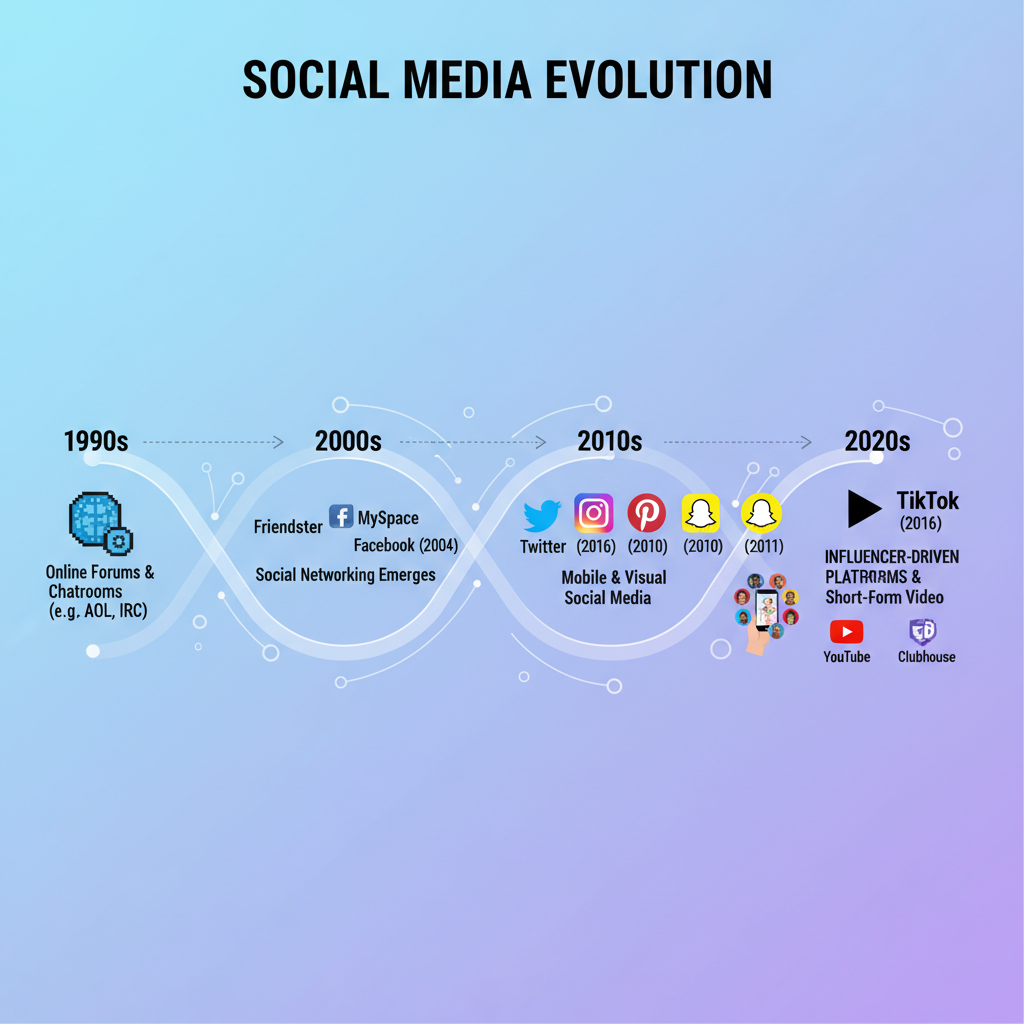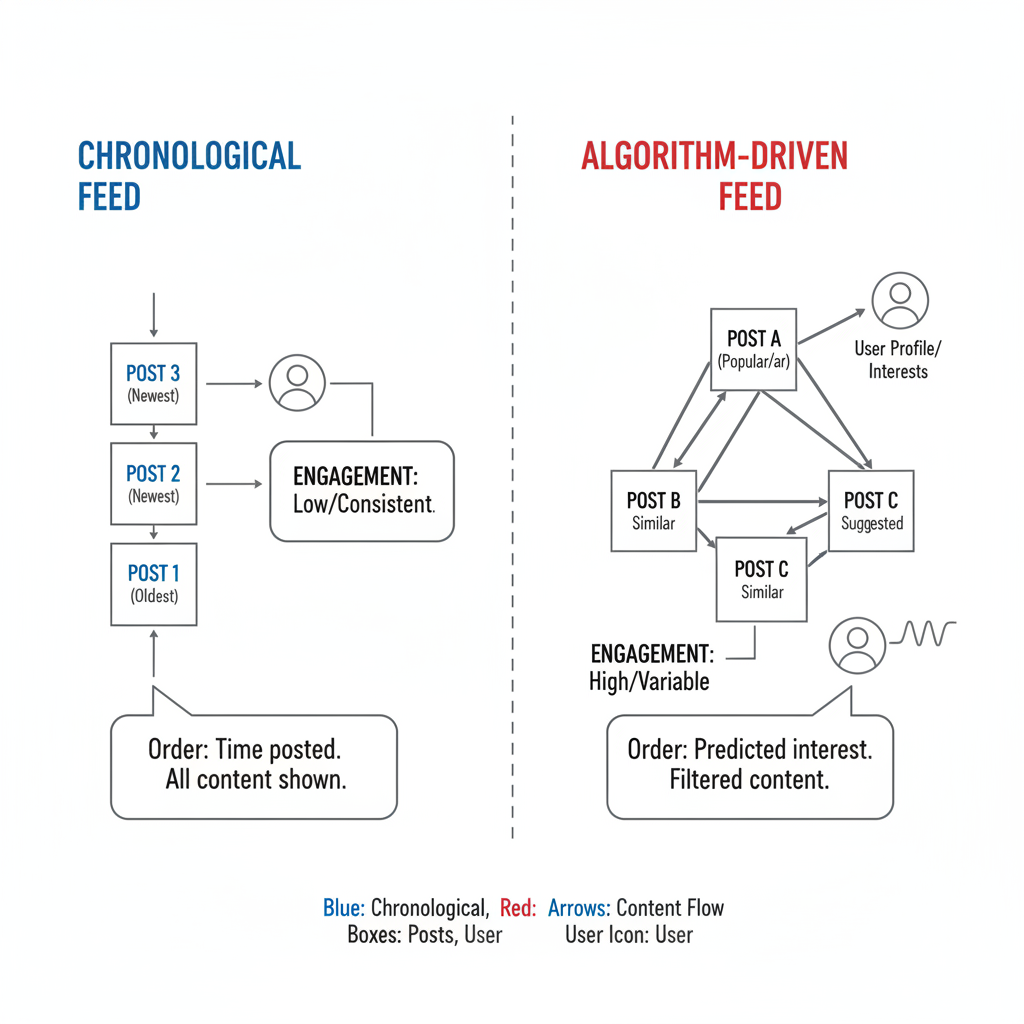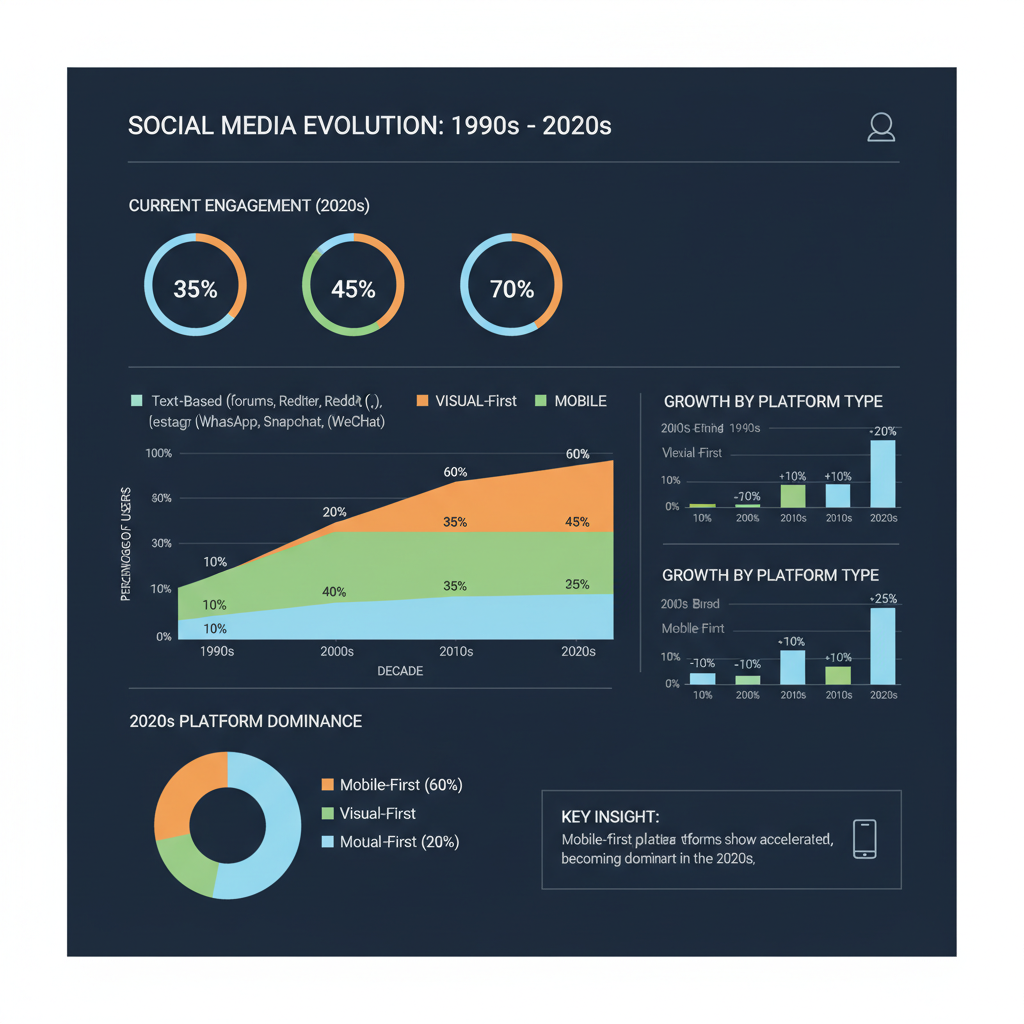How Social Media Has Evolved Since the 1990s
Explore social media's transformation from 1990s forums to mobile-first, visual platforms with algorithm-driven feeds and influencer marketing trends.

Introduction: How Social Media Has Evolved Since It Started
The story of social media’s evolution is one of rapid innovation and cultural transformation. From humble beginnings in the late 1990s and early 2000s, when people gathered in web forums and chat rooms, to today’s sophisticated, AI-powered feeds and immersive virtual environments, the landscape has changed beyond recognition. Understanding how social media has evolved since it started reveals how technology, design, and human behavior have shaped global connectivity, commerce, and activism.

Back then, the question "how has social media evolved since it started" would have sparked curiosity rather than informed debate. Now, we can trace a clear trajectory — from text-heavy boards to video-driven platforms — that impacts relationships, businesses, and social movements worldwide.
---
The Age of Forums and Early Networking Sites
Before the dominance of Facebook and Twitter, online communities thrived in text-based environments. Platforms like Usenet, AOL chat rooms, and niche forums became hubs for people united by shared interests rather than personal branding.
Six Degrees, Friendster, and MySpace
- Six Degrees (1997): Recognized as the first online social network, enabling basic profiles and friend lists.
- Friendster (2002): Exploded in popularity but succumbed to technical issues that hindered growth.
- MySpace (2003): Revolutionized profile customization and integrated music, creating a vibrant hub for artists.
These sites laid the foundations for profile creation, friend connections, and digital identity — features now ubiquitous across platforms.
---
The Birth of Mainstream Platforms: Facebook and Twitter
Around 2004–2006, social networking went mainstream. Facebook began as a network limited to college students before expanding globally, transforming how people shared life updates. Twitter, meanwhile, introduced the microblogging format with a 140-character cap, perfect for real-time conversation.

This era championed:
- Instant updates on breaking news
- Live coverage of events
- Direct celebrity–fan engagement
The advent of Facebook’s News Feed and Twitter’s chronological timeline introduced personalized content streams, setting the stage for algorithmic curation that defines the modern experience.
---
The Rise of Visual Content and Mobile-First Design
Smartphones ushered in a revolution from 2010 onward. With high-quality cameras in every pocket, visual storytelling became dominant, and social media prioritized image and video over text.
Instagram, Snapchat, and Pinterest
- Instagram: Gained fame for photo sharing and filters, appealing to creativity and lifestyle branding.
- Snapchat: Brought ephemeral content and augmented reality lenses into the mainstream.
- Pinterest: Specialized in visual inspiration and discovery for fashion, recipes, and design.
Mobile-first design emphasized vertical scrolling, intuitive touch gestures, and seamless capture-upload workflows, cementing visual-centric engagement.
---
Algorithm-Driven Feeds Replace Chronological Timelines
Originally, posts appeared in simple chronological order. As user bases exploded, platforms introduced algorithms to prioritize content with higher engagement potential, tailoring feeds to individual interests.
Core goals of these algorithms:
- Extend time spent on site
- Surface content most likely to engage
- Drive interaction via likes, comments, shares
While personalization boosted retention, it also fueled concerns over information silos and reduced exposure to diverse viewpoints.
---
Monetization and Influencer Culture
Social media shifted from casual connection to economic powerhouse status. Platforms refined advertising strategies, opening opportunities for personal branding and monetized content creation.
| Era | Monetization Methods |
|---|---|
| 2005–2010 | Display ads, brand pages |
| 2010–2015 | Influencer sponsorships, affiliate links |
| 2015–2020 | Integrated shopping, native ads |
| 2020–Present | Live shopping, subscription content, paid communities |
The influencer economy empowered creators to turn their passion into full-time careers, transforming authenticity and audience trust into valuable commodities.
---
Emergence of Short-Form Video Culture
Short-form video platforms like TikTok, Instagram Reels, and YouTube Shorts showcase bite-sized content designed for maximum engagement. Quick challenges, trending memes, snappy tutorials, and micro-stories thrive in these environments.
Hallmarks of short-form video:
- Vertical orientation for mobile optimization
- Algorithmic trend surfacing
- Creative, fast-paced storytelling
This format has redefined content consumption, capturing attention in seconds.
---
Integration of Ecommerce, Live Streaming, and Social Shopping
Social media increasingly serves as a direct sales channel. Instagram Shops, Facebook Marketplace, and TikTok Shopping make product discovery and purchase frictionless, entirely within the app.
Live streaming accelerates this fusion of entertainment and commerce:
- Hosts demo products in real time
- Audiences participate via interactive chats
- Special deals A/B tested during broadcasts
These integrations offer seamless transaction experiences alongside immersive content.
---
The Role of Messaging Apps and Private Communities
Private communication channels have expanded alongside public feeds. Services like WhatsApp, Facebook Messenger, and Telegram facilitate one-to-one or group messaging with rich media sharing.
Private communities deepen connections through:
- Focused interest groups
- Localized neighborhood networks
- Activist organization channels
This model counterbalances the sometimes superficial nature of public timelines.
---
Privacy Concerns, Data Regulation, and Trust
Platform growth brought intensified scrutiny over privacy. Massive data breaches and revelations on surveillance have shifted public sentiment and led to regulatory changes.
Key issues include:
- Targeted advertising via data harvesting
- Vulnerabilities in third-party app integrations
- Amplification of misinformation
Privacy legislation, such as the GDPR and CCPA, forced transparency improvements, though trust repair remains ongoing.

---
Social Media as a Tool for Activism and Global Connectivity
From grassroots efforts to international campaigns, social media acts as a megaphone for change. Landmark movements like the Arab Spring, #MeToo, and climate action mobilizations leverage viral content to reach millions.
Effective activism strategies:
- Strategic hashtagging to unify messages
- Multimedia storytelling with shareable impact
- Live streaming to prompt immediate responses
Social channels empower marginalized voices and coordinate collective action in unprecedented ways.
---
Future Trends: AI, Metaverse, and Decentralization
Anticipating the future of social media means embracing transformative technologies:
- AI-generated content: Automating creation with tools that personalize media at scale.
- Metaverse experiences: Persistent virtual spaces merging social interaction with business and entertainment.
- Decentralized networks: Blockchain-based, user-owned communities promising enhanced control and security.
These innovations may significantly alter identity management and engagement formats.
---
Conclusion: From Seed to Global Ecosystem
The journey of social media from niche online forums to multifaceted global platforms underscores its transformative nature. For anyone asking "how has social media evolved since it started", the answer is a sweeping story of technological breakthroughs, cultural shifts, and new opportunities.
Today’s social networks are more than communication tools — they are vibrant marketplaces, creative canvases, and activism arenas. As AI, immersive worlds, and decentralized systems mature, social media will continue reshaping human interaction. To stay ahead, watch closely and adapt to the ever-evolving digital sphere.
Want to explore how these changes can influence your strategy? Follow emerging trends now to position your brand and voice effectively in tomorrow’s social media landscape.




